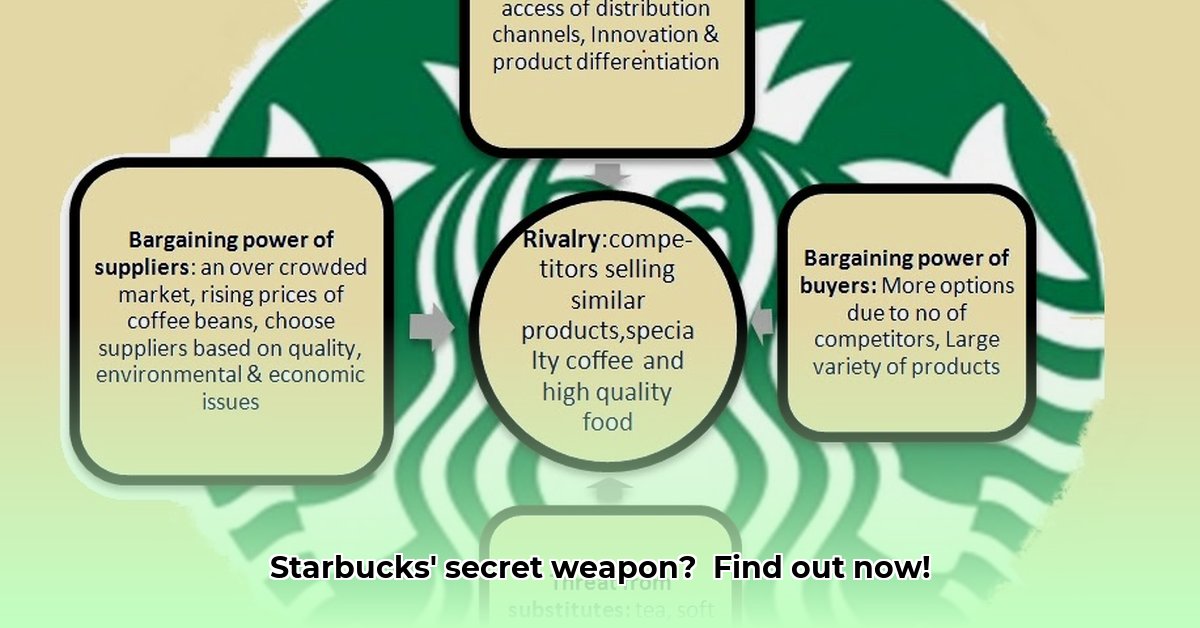
Porter's Five Forces: Deconstructing Starbucks' Competitive Landscape
This analysis utilizes Porter's Five Forces framework to dissect Starbucks' competitive position within the global coffee industry. We'll examine the intensity of each force and identify key strategic implications for the company. Understanding these forces is crucial for Starbucks' continued success in a dynamic and fiercely competitive market. A key question is: How effectively can Starbucks maintain its dominance given these pressures?
Threat of New Entrants: A Moderate, but Persistent, Challenge
While establishing a national coffee chain to rival Starbucks requires significant capital investment and overcoming substantial brand recognition, the threat of new entrants remains a moderate concern. Smaller, independent coffee shops and regional players continue to emerge, often capitalizing on local preferences and unique concepts. This necessitates constant vigilance and adaptation from Starbucks to maintain its market share.
Bargaining Power of Suppliers: A Balanced Equation
Starbucks' massive purchasing volume gives it considerable leverage in negotiating with coffee bean suppliers and other vendors. However, fluctuations in coffee prices, ethical sourcing concerns, and the potential for supply chain disruptions represent ongoing challenges. Maintaining strong, diversified supplier relationships is vital to mitigate price volatility and ensure product quality and ethical sourcing practices. How effectively can Starbucks manage these supply chain risks to maintain its profitability?
Bargaining Power of Buyers: A Significant Force
The high degree of substitution and low switching costs for consumers create significant buyer power. Consumers can easily opt for alternative coffee sources, from home brewing and competing chains to other caffeinated beverages. Moreover, the readily available information online empowers consumers to make informed purchase decisions. Starbucks must consistently deliver exceptional value, customer service, and unique experiences to retain customer loyalty and counter this substantial buyer influence. What innovative strategies can Starbucks utilize to enhance customer loyalty in the face of this considerable buyer power?
Threat of Substitute Products: A Continuous Risk
Numerous readily available substitutes – home-brewed coffee, instant coffee, tea, energy drinks, and other beverages – pose a constant threat to Starbucks' market share. The company must continually innovate and differentiate its offerings to maintain relevance and appeal to evolving consumer preferences. This requires creativity, R&D investment, and a keen understanding of consumer trends. What innovative product developments are needed to diversify Starbucks' product portfolio and reduce the risk of market substitution?
Competitive Rivalry: Intense Competition
The coffee industry is intensely competitive, with numerous players vying for market share. This necessitates relentless innovation, strong branding, superior customer experience, and effective marketing strategies. How can Starbucks maintain its competitive edge amidst this intense rivalry and evolving customer expectations?
Starbucks' Strategic Responses: Adapting to the Shifting Landscape
Starbucks' success hinges on its ability to proactively address these forces. Key strategic responses include:
- Brand Enhancement: Maintaining a premium brand image is crucial to mitigating buyer power and the threat of substitutes.
- Innovation: Continuous product development, including new beverages, food items, and store experiences, is vital to differentiate offerings and retain customer interest.
- Supply Chain Optimization: Efficient operations and strong supplier relationships are necessary to mitigate supplier power and address price volatility.
- Customer Loyalty Programs: Robust loyalty programs are pivotal in combating buyer power and fostering customer retention.
- Ethical and Sustainable Sourcing: A commitment to ethical and sustainable practices strengthens brand image and enhances appeal to environmentally conscious consumers.
Actionable Steps: A Roadmap for Starbucks' Future
Based on this analysis, Starbucks' strategic roadmap should include:
- Enhance Loyalty Programs: Implement tiered loyalty programs offering personalized rewards, early access to new products, exclusive experiences, and increased customer engagement.
- Accelerate R&D Investment: Allocate significant resources to product innovation, new beverage development, and store environment enhancements to maintain a competitive edge and expand customer appeal.
- Strategic Market Expansion: Explore both domestic and international market expansion opportunities, adapting product offerings to align with local preferences.
- Diversify the Supply Chain: Enhance supplier diversification to mitigate risks associated with single-source dependency, price volatility, and supply chain disruptions.
- Strengthen Digital Engagement: Invest in and enhance the digital customer experience through the mobile app, online ordering, and personalized marketing initiatives to improve customer reach and engagement.
Key Takeaways: Starbucks operates in a highly competitive market where buyer power, substitution threats, and rivalry significantly impact its profitability and long-term success. Mitigating these threats and capitalizing on strategic opportunities requires a multi-pronged approach focusing on innovation, customer loyalty, supply chain resilience, and brand enhancement.